Trueflight’s Wild New Camo patterns – Now in Full Production!
We’re happy to report that our new Camo patterns are now in full production in a huge range of colors, sizes and shapes. The new patterns are available in both “traditional” camo colors like “Traditional Bronze”, “Leaf Green”, “Autumn Brown”, etc. as well as “Bright Stripes” colors like “Orange/Chartreuse”, “Red/White” and “Chartreuse/White” among others.
Free samples of the Camo patterns are being sent out upon request. We’ll do our best to send the color, size, shape and wing requested, but may have to substitute something close depending on available stock.
The new Camo patterns are priced the same as our popular “Trueflight Barred”. We can supply these patterns in any of the sizes and shapes we sell, from “Full Length” to “2 inch shield back”. That’s lots of choices... something perfect for any arrow. The fletching has always been the most “eye catching” part of any arrow and the Camo patterns are something new and different – something bound to attract attention.
�
1900 DIFFERENT Trueflight Feather Choices....
Decisions, decisions, decisions... At Trueflight, we supply 14 different solid colors, plus 18 Trueflight Barred colors, plus 18 Camo colors, plus 18 “Mini Barred” colors.... all available in your choice of 14 different sizes and shapes, as well as left or right wing. If my math is right, that means we sell over 1900 different items. That’s a lot to keep track of for a small company like us, but it sure means a huge range of choices for our customers!
It seems we have nearly every color imaginable... from white to black, to pink, to purple... and patterns in “super hidden camo” to wildly bright “Bright Stripes”. And all of these color choices are available in any of our 14 different sizes and shapes including Round Back, Shield Back, Full Length, in die-cuts from 2 inches to 5.75 inches in length. Of course, we’re not even counting “custom trimmed” diecuts that you can easily make yourself (as shown in last year’s newsletter)... even more choices!
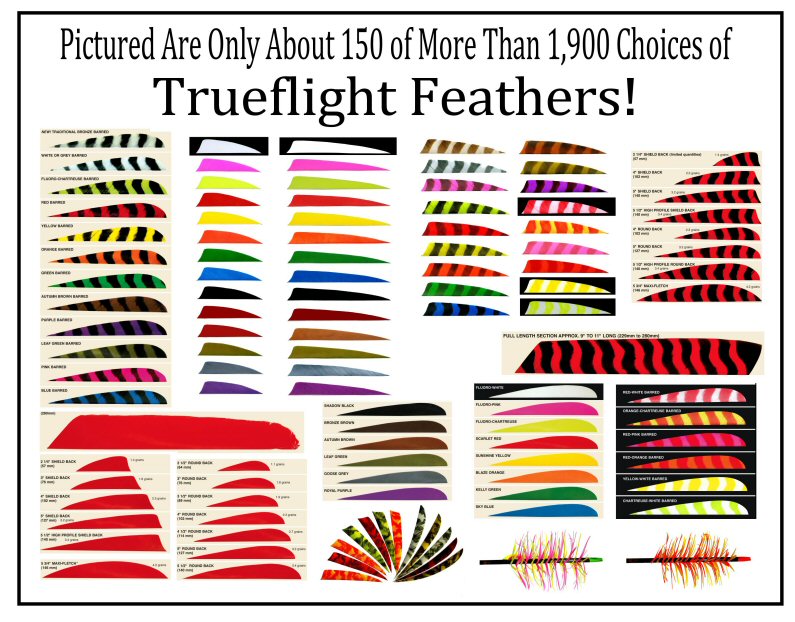
Naturally, the size choice for diecuts is going to be made based on the arrow, the shooter and type of shooting being done. But once the basic size has been fixed, there is still an abundance of choice in the color and pattern of the fletching. Sure, in a given size and shape, the colors and patterns will all fly the same... but the colors and patterns in the fletching are what give the arrow it’s character! The “eye appeal” of an arrow is mostly determined by it’s fletching.
Since we typically fletch an arrow with 2 colors of feathers... (one “cock” feather and 2 “hen” feathers with the cock feather marking the 90 degree position on the string) how many different combinations of color and barred are possible? Well if we consider only solid colors and Trueflight Barred patterns in one particular size, shape and wing, it appears that there are about 496 different choices of 2 color combinations! I’m starting to wonder if any 2 sets of arrows have ever had identical fletching. If you add in possible Camo or Mini Barred pattern choices.... my calculator doesn’t go that high!
Bob Link our general manager and his handful of assistants here have the job of organizing production of this mind boggling list of items. I’m sure glad that’s his job, not mine. If you consider just the scheduling of 14 solid colors and 18 Trueflight Barred colors, the internet tells me there are approximately 263,130,836,900,000,000,000,000,000,000,000,000 possible different orders in which they could be produced. You can’t say he doesn’t have a lot of options in his schedule!
(And no, we aren’t making up that number... we spent a considerable amount of time counting and re-counting all those zeros to make sure we got it right.)
Dr. Ashby, Broadhead Penetration Expert on the Importance of STRAIGHT AND STABLE ARROW FLIGHT:
“... Perfect arrow flight is the enabler for all the other factors that affect arrow penetration. One should spare neither effort nor expense to achieve perfect arrow flight. No matter what arrow setup you use, unless arrow flight is as perfect as you can achieve you are robbing your arrow of much of its terminal performance potential.”
(Arrow Trade, May 2012, Page 79 by Todd Smith)��
The Spin on ARROW SPIN
In archery, “One size DOESN’T fit all...” When we are asked for recommendations on particular choices in equipment, etc. we always start out by mentioning that there are so many possible variations in equipment, shooting style and so on that actual test shooting by the actual shooter is the only way of knowing for sure how well a particular set up works for a particular shooter.
However there is one UNIVERSAL recommendation which we think applies to virtually all arrows in all circumstances. We strongly believe that all arrows should “spin” or rotate in flight. This generally means that the fletching of the arrow should be “offset” (or angled) with respect to the axis of the arrow or fletched in a helical spiral to make sure the arrow spins as it flies
.
Why is this so important?
1) No arrow is ever made 100% perfectly symmetrical without at least some, even microscopic imperfections in it’s shaft, head, nock, paint, glue, or other parts. A microscopic imperfection may not seem important, but that tiny variation will tend to slightly pull the arrow off it’s intended path. If the arrow does not spin, what started as a slight deviation becomes greater and greater the further down range it flies. What begins small soon builds up to a large error at the target. Since no 2 arrows are ever precisely identical, a set of non spinning arrows will tend to “scatter” and not group well. This is definitely not a good thing. Spinning arrows will tend to “average” out these errors.
2) An arrow (or most anything else) that is spinning tends to maintain it’s axis of rotation in a constant direction. This is due to the same gyroscopic forces that keep the earth’s axis of rotation in a (almost) constant direction. Such “spin stabilization” is a very handy way to keep a constant orientation of everything from space satellites to rifle bullets, to figure skaters to entire planets. A spinning archery arrow has a “built in” resistance to disturbances from air currents, and obstacles like tree branches.
Are these the same reasons rifles have spiral groves in their barrels, to spin bullets?
Exactly! Back in the “black powder days”, a smooth bore musket fitted with a rifled barrel suddenly became roughly 3 times more accurate, and correspondingly had about 3 times the effective range.
Does an arrow spin fast enough for this gyroscopic stability to be important?
Yes, it sure does! A typical archery arrow with helical or offset fletching has been measured to spin at over 1200 rpm.
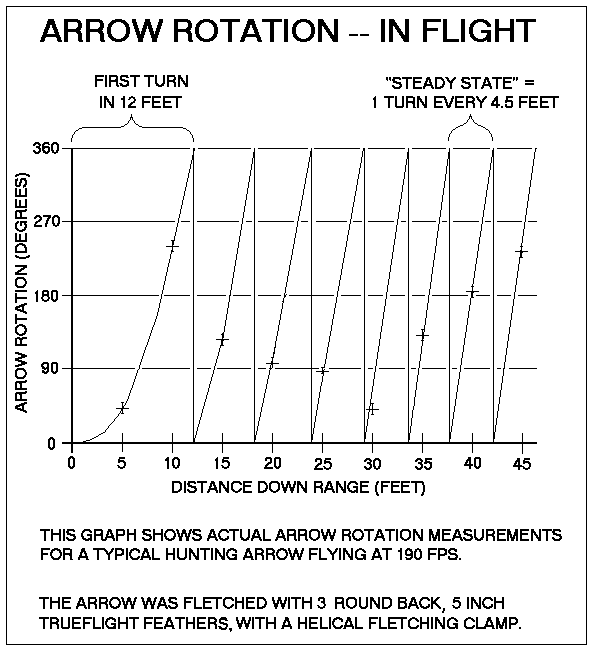
But doesn’t spinning the arrow reduce it’s down range speed?
Surprisingly, there is little if any speed loss due to arrow rotation. Once the arrow has “spun up” to a constant speed with the rotation rate matching the angle of the fletching (typically in the first 20 feet of flight) there is virtually no additional drag on the arrow. Calculation shows that the amount of energy required to “spin up” an arrow is very small. Actual chronograph measurements out to practical hunting ranges (60 yards) also show very little difference in downrange speeds for straight, offset, or helical fletching. (This does NOT apply to those plastic vanes with a “kicker” or deflector vane on their trailing edge.)
Does the direction of rotation (clockwise or counter clockwise as viewed by the shooter) make any difference?
Generally, no. In some specific cases one direction or the other may give a bit better clearance from bow components, etc. Also, some broadheads are designed for a specific rotation direction.
However, Right Wing feathers should be used for clockwise rotation, and Left Wing for counterclockwise rotation. This is due to differences in the surface roughness of the feather web, which make for a natural tendency to rotate the arrow.
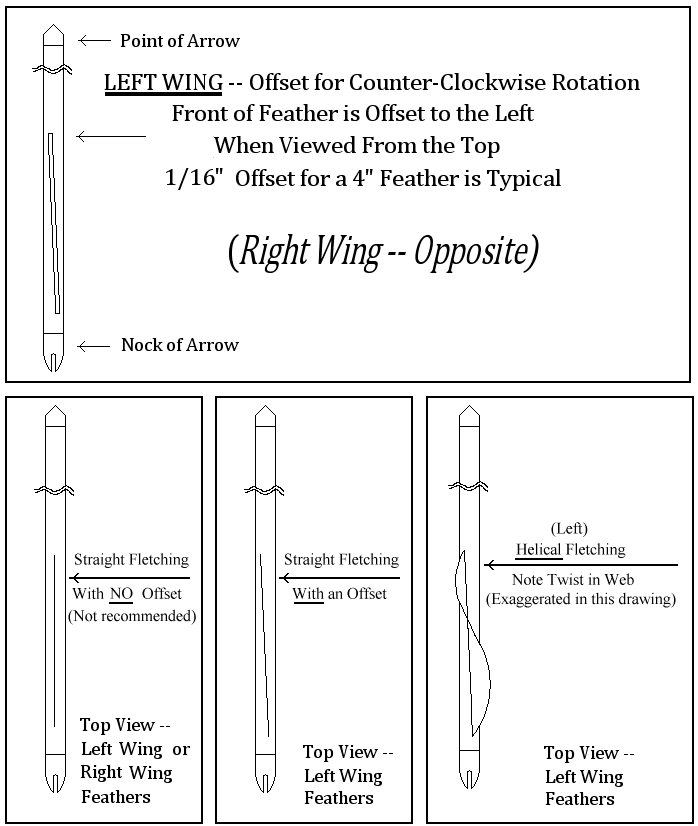
PHEASANT HUNTING WITH A BOW – THE DVD!
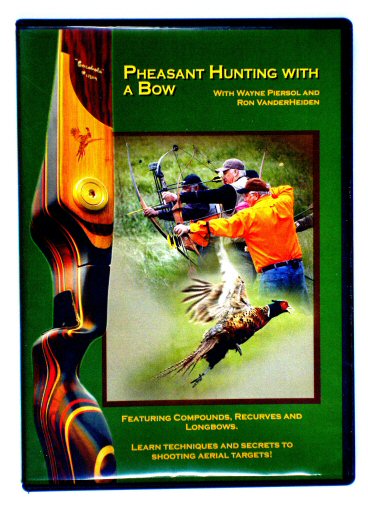
We’ve been having a great time shooting at flu-flu’s at flying disks, milk jugs and most everything else we get in the air, or at least roll along the ground. And yes, some times we even hit what we are aiming at! Hitting a flying or moving target is “a whole new ball game...” It’s generally instinctive shooting at it’s best – challenging and relaxing.
But what about the ultimate flying target... can you hunt Pheasant with a bow? Yes indeed you can! And what better way to get started than studying a DVD with detailed instructions on everything from equipment, to target practice, to cooking your Pheasant?
Wayne Piersol and Ron VanderHeiden have created a great instructional video which explains all you need to know about hunting and cooking Pheasant. “Pheasant Hunting with a Bow” is a very professionally done DVD which provides hours of excellent instruction for even a beginning “Pheasant hunter.” Even if you’ve never tried shooting an aerial target of any kind, this DVD will get you “up to speed” on everything from equipment through cooking. You will need to do some practice... but even that is covered with “Pheasant specific” suggestions for realistic practice with a milk jug and an assistant.
For more information contact:
ron@rescuemetoo.com
or call 510-708-7001.
Bob Link (Finally!) Gets His Turkey!

For at least 15 years Bob has been patiently trying to take the wile and ever elusive wild turkey with a bow. While he has managed to take several very nice Pope & Young whitetails in that time, the turkeys proved to be a much greater challenge.
It seems that every year Bob came back with some exciting tales of calling in some nice birds, but never came back with a turkey... or even some feathers! We concluded that those turkeys were smarter and more wary than any deer. They always seemed to know just the distance to be out of bow range and have a fantastic ability to spot a hunter even through the best camouflage. Meanwhile bob got a lot of experience “talking turkey” and definitely enjoyed doing that even with the birds wisely keeping their distance.
This spring Bob set us his usual Northern Wisconsin improvised “Balsam tree thicket” blind and managed to persuade a good sized “Tom” to come in for a closer look at a home made decoy which featured a real feather tail fan. At less than 20 yards the distracted Longbeard met his end.
Bob reports that the bird weighed 22 lbs, had a 9 ½ inch beard and 1 inch long spurs. It certainly had beautiful feathers which Bob preserved in tail fan and wing displays.
I think most hunters will agree, a wild turkey is one of the most challenging prey to take with a bow. These birds really do have superhuman vision and maybe even a “sixth sense” for danger on the ground. Bob is planning on going right back at it for the next season. He says even if takes another 15 years, calling and matching wits with “the big girds” is exciting and well worth the effort... even without getting in a shot.
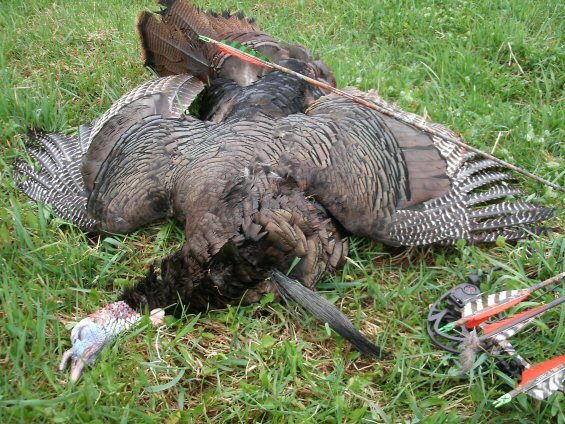
Text and Photos copyright 2012, Trueflight Mfg. Co., Inc.
Home -
Feathers Vs Vanes -
Fletching Guide -
Products -
Examples -
Buying -
Distributors -
Newsletter -
FAQ






